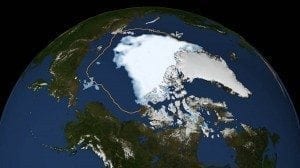Scientists have long modeled the expected warming due to the decreased albedo effect as melting Arctic sea ice exposes more open ocean. As early as the 1960’s climate researchers have predicted how this phenomenon will amplify global warming.
 Arctic ice melt, albedo and global warming
Arctic ice melt, albedo and global warming
Albedo is measured as a percentage, in this case the percentage of solar radiation a surface reflects back into space. High albedo represents a highly reflective surface, like sea ice. Dark surfaces, such as ocean surface water, have low albedo. The albedo of fresh snow is typically between 80 to 90 percent, whereas for open ocean it is less than 20 percent. Other factors such as clouds also have an overall effect on albedo.
The bright sea ice reflects solar radiation back into the atmosphere. When the ice melts the darker ocean that is exposed absorbs this solar energy instead of reflecting it back into space. Less sea ice exposes more open ocean, warming the surrounding ocean and air, causing more sea ice to melt, causing more warming, and on it goes in positive feedback loop.
Research from the Scripps Institution of Oceanography at the University of California in San Diego now shows the impact of melting arctic sea ice on global warming has likely been significantly underestimated. Results of the research, released on Monday in the Proceedings of the National Academy of Sciences, uses 30 years of satellite observations rather than relying solely on computer climate models. The study found the impact of decreasing albedo to be two to three times larger than previously estimated.
“It’s fairly intuitive to expect that replacing white, reflective sea ice with a dark ocean surface would increase the amount of solar heating,” said Kristina Pistone, one of the principal researchers in the study. “We used actual satellite measurements of both albedo and sea ice in the region to verify this and to quantify how much extra heat the region has absorbed due to the ice loss. It was quite encouraging to see how well the two datasets – which come from two independent satellite instruments – agreed with each other.”
The Arctic is warming at a much faster rate then mid-latitudes. Since the 1970’s the Arctic has warmed by 2 degrees Celsius (3.6 degrees Fahrenheit) and summer minimum sea ice extent has decreased by 40 percent. Pistone and her colleagues have calculated that albedo in the Arctic region has fallen from 52 percent in 1979 to 48 percent in 2011.
“Based on our results, the albedo forcing from Arctic sea ice retreat is quite large,” said Ian Eisenman, assistant professor of climate dynamics at Scripps. “Averaged over the entire globe, it’s one-fourth as large as the direct radiative forcing from CO2 during the same period. This suggests that Arctic sea ice retreat has been an important player in the global warming that we’ve observed during recent decades. Although more work is needed, a possible implication of these results is that the amplifying feedback of Arctic sea ice changes on global warming is larger than previously expected.”
Image credit: NASA Goddard Space Flight Center, courtesy flickr


